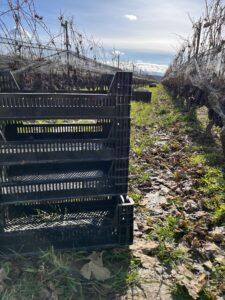
In a prior blog, we talked about the important role sugar plays in wine. Acidity is another vital component, shaping a wine’s flavour, structure and overall character. From a chilled Sauvignon Blanc to a full-bodied Cabernet Sauvignon, acidity plays a pivotal role in what makes wine so enjoyable. Read on to further understand the role of acidity in wine.
What is the Role of Acidity in Wine?
Acidity in wine refers to the natural acids present in the grapes and those formed during fermentation. The primary acids in wine are tartaric, malic, citric acids and lactic acid. Together, these acids contribute to the wine’s freshness, balance and longevity.
A Further Look at the Types of Acidity in Wine 
Tartaric Acid: This is the most prominent acid in grapes and wine, providing structure and stability. Tartaric acid plays an important role chemically, lowering the pH of fermenting “must” to a level where many undesirable spoilage bacteria cannot live. It acts as a preservative after fermentation.
Malic Acid: This is another naturally occurring acid found in grapes, and it plays an essential role in the winemaking process. Malic acid is commonly used to adjust the acidity levels in wine and to enhance the overall flavour profile of the finished product. This type of acid contributes a sharp, tart taste. Its concentration decreases the more a grape ripens.
Citric Acid: Wines that are naturally lacking acid are flat tasting. Citric acid can be added to wine to help bring out a fresher, fruity citrus note on the palate.
Lactic Acid: This type of acid is not naturally present in grapes but can be used in winemaking to adjust the acidity of the wine and bring out specific aromas and flavours. Lactic acid is typically added during the secondary fermentation process.
Why Acidity in Wine Matters
 Balance: Acidity counterbalances sweetness, fruitiness, and tannins. For instance, Riesling relies on its high natural acidity to keep its sweetness in check, while a bold red wine uses acidity to harmonize with its tannin structure.
Balance: Acidity counterbalances sweetness, fruitiness, and tannins. For instance, Riesling relies on its high natural acidity to keep its sweetness in check, while a bold red wine uses acidity to harmonize with its tannin structure.
Aging Potential: High acidity helps preserve wine over time. Acidity acts as a natural preservative, making wines age gracefully for decades.
Food Pairing: Wines with good acidity are often the most versatile with food. They can cut through rich, fatty dishes, complement citrusy or tomato-based sauces, and refresh the palate between bites.
Regional Expression: Acidity reflects the terroir where the grapes are grown. Cooler climates typically produce wines with higher acidity due to slower ripening, while warmer climates often yield lower-acid wines.
The Sensation of Acidity
Acidity is most noticeable on the palate as a tingling or puckering sensation, especially along the sides of your tongue. It’s what gives a wine its crispness and vibrancy. Without acidity, wine can taste flat, dull, or overly sweet.
Does Harvest Time Affect Acidity? 
Winemakers can influence a wine’s acidity by choosing the right harvest time. Grapes picked earlier have higher acidity and lower sugar levels, while later harvests yield riper, sweeter fruit with lower acidity. In addition, winemakers may adjust acidity during the winemaking process by adding tartaric acid or blending with high-acid wines
How to Recognize Acidity in Wine
When tasting wine, pay attention to how quickly your mouth waters after taking a sip. The more your mouth waters, the higher the acidity. High-acidity wines feel refreshing and energizing, while low-acidity wines feel richer and softer.
Acidity is the backbone of wine, providing structure, balance, and a lively character. Whether you’re savouring a zesty white or a bold red, understanding the role of acidity will enhance your appreciation for the art of winemaking.
